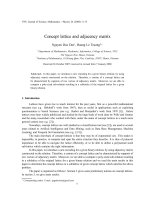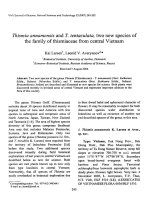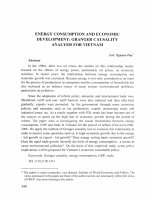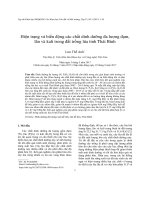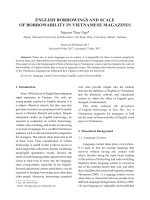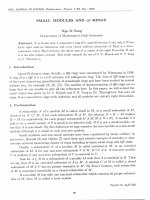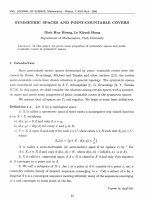DSpace at VNU: Concept lattice and adjacency matrix
Bạn đang xem bản rút gọn của tài liệu. Xem và tải ngay bản đầy đủ của tài liệu tại đây (3.38 MB, 5 trang )
VNU Journal of Science, Mathematics - Physics 24 (2008) 11-15
Concept lattice and adjacency matrix
N guyen Due D a t^ H oang Le Truong^’*
^D ep a rtm ent o f M athem atics, M echanics, Inform atics, C o lleg e o f Science, VN Ư
334 N guyen Trai, H anoi, Vietnam
‘^ In stitu te o f M athem atics, Ỉ 8 H o a n g Q uoc Viet, CauG iay, Ỉ0 3 0 7 , H anoi, Vietnam
R eceived 26 O ctober 2007; received in revised form 7 January 2008
A b s t r a c t . In this paper, w e introduce a new encoding for a given binary relation, by using
adjacency m atrix constructed on the relation. T herefore, a coatom o f a concept lattice can
be ch aracterized by supports o f row vectors o f adjacency m atrix. M oreover, w e are able to
com pute a p oly-sized sub-relation resulting in a sublattice o f th e original lattice for a given
b in ary relation.
1. In tro d u c tio n
Lattices have given rise to much interest for the past years, first as a powerful mathematical
structure (see e.g. BirkhofPs work from 1967), then as useful in applications such as exploiting
questionnaires is Social Sciences (see e.g. Barbet and M onjardet’s work from 1970 [I]). Galois
lattices were later w idely publicized and studied by the large body o f work done by W ille and G ranter
and the many researchers who worked with them, under the nam e o f concept lattices in a much more
general context (see e.g. [2 ]).
Nowadays, concept lattices are well-studied as a classification tool (see [2]), are used in several
areas related to A rtifical Intelligence and D ata M ining, such as D ata Base M anagem ent, M achine
Learning, and Frequent Set Generation (see e.g. [3-5]).
The main draw back o f concept lattices is that they may be o f exponential size. This makes it
impossible, in practice, to compute and span the entire structure they describe. It is thus o f primeval
importance to be able to navigate the lattice efficiently, or to be able to define a polynomial sized
sub-lattice which contains the right information.
In this paper, we introduce a new encoding for a given binary relation, by using adjacency matrix
constructed on the relation. Therefore, a coatom o f a concept lattice can be characterized by supports o f
row vectors o f adjacency matrix. Moreover, we are able to compute a poly-sized sub-relation resulting
in a sublattice o f the original lattice for a given binary relation and we used the main results in this
paper to determ ine the concept lattices or a sublattice o f given concept lattice which satisfies the above
problem.
The paper is organized as follows: Section 2 gives some prelim inary notions on concept lattices.
In section 3, we give main results.
Corresponding author. E-mail:
11
12
N.D. Dai, H.L. Truong / VNU Journal o f Science, Mathematics - Physics 24 (2008) 11-15
2. P relim in aries
In this section, let us recall the notion o f concept lattice as far as they are needed for this paper.
The definitions in this section are quoted from [5]. A more extensive overview is given in [3]. To
allow a m athem atical description o f extensions and intentions, concept lattice starts with a (formal)
context.
D efinition 2.1. A fo r m a l context is a triple K := (G; M ; R ) where G and M are sets and R C G x M
is a binary relation. The elements o f G are called objects and the elem ents o f M attributes. The
inclusion {g-,m) e R is read ’’object g has attribute m ”. For A c G, we define
A ' := { m e MỊVgr £ A
: (p ;m ) G R
and fo r B c M , we define dually
B'
:=
{g e G\im e B :
e R}.
We assum e in this article that all sets are finite, especially G and M . A context K with |G | = k
and \ M\ = ^ is called an k -h y -i context. The proofs o f the following results are trivial therefore we
omit them.
L em m a 2.2.
L et { G ; M - , R ) be a context, A ị \ A 2 c G sets o f objects, and Bị - , D 2 C M sets o f
attributes. Then the fo llo w in g holds:
(1)
c Ẩ 2 =»
c A \ and B i c B 2 B '2 c D\.
(2) ^ c A " and B c B " .
(3) A ’ = A '" a n d B ' = B '" .
(4) A c B ' ^ B c A ' ^ A X B c R.
D efinition 2.3. A fo r m a l concept is a p a ir [A] B ) with A C G , B C M , A ' = D and D' =: A . (This
is equivalent to A Q G and B c M being m axim al with A X D c R .) A is called extent and B is
called intent o f the concept. The set o f all concepts o f a fo r m a l context K together with the p a rtia l
order (A i; D i) < ( A 2 ; B 2 )
A \ c A 2 (which is equivalent to D 2 c B ị ) is called concept lattice o f
K and denote by C { R ) = £ (G ; M ; R).
Such a lattice, som etim es refered to as a complete lattice, has a sm allest element, called the
bottom elem ent, and a greatest element, called the top element.
An e le m e n t { A \ \ D i ) is said to be a predecessor o f elem ent (A] D) if A i c A. An element
is said to be a ancestor o f element {A] B ) if
c
and there is no intermediate element
( ^ 2 ; B 2 ) such that A i c A 2 c A. The ancestors o f the top element are called coatoms.
Let K := ( G ; M ; R ) and K ' := { G ' \ M ' \ R ' ) be two contexts. We call K and K ' isomorphic,
and write K = K ' , if there exists two bijections ip : G ^ G' and p : ẢÍ —> M ' such that {g] m) e
R <i=> {ip{g)] p { m ) ) e R ' fo r all 5 6 Ơ and m e M .
T heorem 2.4. [The b asic theorem o f C o n cep t L attice [5]] The concept lattice o f any form al context
{ G \ M ] R ) is a com plete lattice. For an arbitrary set { { A ị - Bi )\ i e /} c C { G ; M ; R ) o f fo rm a l
concepts, the siiprem um is given by
N.D. Dat, H.L. Truong / VNƯ Journal o f Science, Mathematics - Physics 24 (2008) Ỉ1-Ỉ5
13
and the infimum is given by
ie ĩ
ie ỉ
ie ĩ
A com plete lattice L is isom orphic to C{G \ M \ R ) i f f there are m appings 7 : G
such that 7 (G ) is siipremum-dense and ị i [ M) is infm um -dense in L, and
g R m 4:^ 7 (5 ) <
In particular, L = £ (L ; L; < ).
The theorem is less complicated as it first may seem (see [5]). We give some explanations
below. Readers in a hurry may skip these and continue with the next section.
The first part o f the theorem gives the precise formulation for infimum and suprem um o f arbitrary
sets o f formal concepts. The second part o f the theorem gives (among other information) an answer
to the question if concept lattices have any special properties. The answ er is ”no” ; every complete
lattice is (isomorphic to) a concept lattice. This means that for every complete lattice w e must be able
to find a set G o f objects, a set M o f attributes and a suitable relation R, such that the given lattice is
isomorphic to £ (G ; M ; R ). The theorem does not only say how this can be done, it describes in fact
all possibilities to achieve this.
3. T h e m ain results
In the section we assum e that K := { G \ M \ R ) is a context w ith G —
and
M — { m i , . . ., m i ) . The adjacency matrix X = {aij)i xk o f a context K := (Ơ; M ; R ) is defined by
aij = 1 if { g j \ mi ) e I and a i j = 0 otherwise. We denote by X k the adjacency m atrix o f a context
K . Then we denote by Vi the
row vector o f the adjacency matrix X k and by V { K ) the set o f row
vectors o f the adjacency matrix
For a vector V — ( x i , .. .,Xfc) o f V { K ) , S u p p { v ) = {i \ X i =
1} c [1, /c] = { 1 , . . , , k } and conversion for a subset z o f [1, fc], we denote by Vz the vector in V { K )
such that z = S u p p iy z ) - For a subset A o f G , we denote by Ẩ = {i I ổi G >1} and conversion for a
subset z o f [1 , k], we denote by A z the subset o f set G such that z = A z E x am b le 3.1. Let a binary relation between set G = {gi, 9 2 , 9 3 , 9 4 , 9 5 } and M = { m i , m 2 , m 3 , m 4 }
be the below table. Then the row vector V2 = ( 1 ,1 ,0 ,0 ,0 ) and S u p p { v 2 ) = { 1 ,2 } . Let z =
{2, 3, 4} c [1, 5] then
= {ổ 2 , ổ 3 ,
91
92
93
94
95
m i
0
1
1
0
0
7712
1
1
0
0
0
m
3
1
0
1
1
1
7714
1
0
0
1
1
N ow by Theorem 2.4, every vector o f V { K ) is attached to a unique concept. Let K :=
(G; M ; R ) be some formal context. Then for each vector V o f V { K ) the corresponding a concept is
ip{v) := {^Supp{vỳ-^Supp{v))L e m m a 3.2. L et K := { G \ M \ R ) be a context. Then fo r all vectors
A"
^ S u p p (v ) = A^Supp(v]
V
ofV{K),
14
N.D. Dat, H.L. Truong / VNU Journal o f Science, Mathematics - Physics 24 (2008) ỈỈ-Ỉ5
Proof. The inclusion
Then since g G
c
and
is trivial. A ssum e that g e
such that g 0
c R . Note
^ 5 „pp(,)) is a concept, w e have {(?} X
that the vector V corresponding with an element m o f M and m oreover m E A'g
( g , m) e R and so that g e Asupp{v), a contradiction. H ence
y
Therefore
= Asupp(v) as required.
Let V = {xi , .. . , Xk) and w = { y i , ---- yk) be tw o vectors in R*". T hen w e denote by v'^ =
x Ị + .. , + x ị aná v w = X i y i + . . . + XkVkP roposition 3.3.
Let X be a subset o f coatom o f a concept lattice C{ R) . A ssu m e that a vector
Vi satisfies the condition v f = m ax {Vj I Supp{ v j ) 2 I n { X ) =
IJ
A ) . Then the concept
{A-B)ex
{A; B ) corresponding with Vi is a coatom o f C{R).
Proof. A ssum e that {A\ B ) is not a coatom.
Then there exists a concept {A ị \ B i) such that A c A ị . Let m t e B i . Since [Ai] B ị ) is a concept,
we get that A ị X { m t } c R . Then A \ c Asupp{vt)
so th at A = Sup p{ v i ) c Supp{vt ) . Since
Su pp{vi) g I n { X ) , we have S u p p {vt) Ễ I n { X ) . Hence, Vị < v f and S u p p { v t) % I n { x ) in
contradiction by v f = m ax { v j I Supp{ v j ) g I n { x ) } . Thus {A\ B ) is a coatom o f C{R) .
T heorem 3.4. We use the above notation. Then the fo llo w in g two statem ents are equivalent.
(Ỉ) A concept [A] D ) is a coatom o f C{R).
(ii) Vector y =
satisfies the condition S u p p ( v ) 2 S u p p { v i) f o r a ll vectors Vi such that
v ị > v^.
Proof, ( i ) ^ (ii) A concept [A] B ) is a coatom. Let V = vrj. T hen A % A ị for all A \ Ỷ ^ and A ị is
a extent o f any concept. By Lemma , if a vector Vi satisfies v f > v'^, then S u p p { v i) g Supp{v) .
(ii)=> (i) Let be a vector such that S upp{ v ) 2 S u p p { v i) w here a vectors Vi satisfies
< Vị .
Assume that a concept {A\ D ) where A = Asupp(v) is not a coatom . Then there exists a concept
( Ai ' , Bi ) such that A c A i . Let m t e B i . Since A i X B ị is a concept, we have A i X { m i } c R.
Therefore A] c Asupp{vi)- Then we obtain Supp{ v ) c S u p p { v i), and so that v ‘^ < V ị , a contradiction.
Hence {A-, B ) is a coatom.
C o ro llary 3.5. Let ( A \ B ) be a coatom o f lattice C{R) . Then w e have
= m ax{t;^ I Sup p{ v ) g S u p p {vị) for all v f >
and V € V { K ) } .
Proof. Put c = { v \ S u p p { v ) g S u p p {vi) for all v f > v ^ , v E V { K ) } . Since { A - B ) is a coatom
by Theorem , w e obtain S u p p { v j) <Ị- S u p p {vi) where a vector Vi satisfies v f > v ^ .
Therefore
v^r < m ax u ^. For all V E c ,
< v \ , we have m ax ti^ < v \ . H ence
— m a x iu ^ S u v n (v ) 2
■4 - v e B
’
- A’ '
^
-4
>■
i'i'K J ^
S u p p {v i) for all v f >
a n d V € V { K ) } , as required.
Note that a vector V e V { K ) corresponds with a concept w hich is coatom or w ithout. Moreover,
two vectors Vi and V j are dififerent but they correspond with a sam e concept.
C o ro lla ry 3.6. L et V and w be two vectors in V { K ) such that
an d Asupp(w)
extents
o f any coatoms. Then the fo llo w in g two statements are equivalent.
(i) Vectors V and w correspond with a same coatom.
(ii) S u p p { v ) = S u p p {w ).
(in)
= up' = vw .
Proof. ( i ) o (ii) and (ii)=4> (iii) are trivial.
(iii)=» (i): Since entries o f vectors V and w are 0 or 1 if S u p p { v ) <Ị- S u p p { w ) then v'^ > vw. Therefore
S u p p ( v ) = S u p p { w) .
N.D, Dai, H.L. Truong / VNV Journal o f Science, Mathematics - Physics 24 (2008) 77-75
L e t V { R ) = {'U e V { K ) \
ie[i,k]
15
= {(^S tx p p ^; ^ 5 „pp(v))l^ e V{ỉ ^) }-
C o ro llary 3.7. A set Xf z is a subset o f coatom s o f the lattice C{R).
Proof. Let {A; D ) E X a . T hen a vector V j satisfies the condition
= m ax v f } , and thus there
dosen’t exists a vector w such that
> v ^ . By Theorem , a concept {A; B) is a coatom as required.
E x am p le 3.8.
Let K = (G ;Ẳ Í ;i? ) be as in Example . Then we have
~ ( 1 ,0 ,0 ,1 ,1 ) and so
that (p('6’4 ) = ( { ổ i,ổ 4 ,P 5 }; { 7713, 7714}) is a concept o f lattice C{ R) by Lemma . Moreover, we have
= v ị = 2, v ị ^ 4 and v ị = 3. Then by Theorem , we get that
is not a coatom o f this
lattice sin ce
Supp{v^)
S i L p j ) { v 2 ) % S u p p { v ‘^ )
c
Supp{v^).
and
O n the other hand,
S u p p { v ‘2 )
2
^{v2)
=
{{9 1,9 2}] {m 2 })
is a coatom b e cau se
Sw p p {vị).
R eferences
111 M. Barbut, B. Monjardct, Ordre et classification, Classiques íỉachelle, 1970.
[2| B. Ganter, R. Wille, Formal Concept Analysis, Springer, 1990.
[3] M. Ituchard, II. Dicky, M. Leblane, Galois lattices as framework to specify building class hierarchies algorithms,
Theoretical Informatics and Applications, 34 (2000) 521.
[4] J.I. Pfaltz, C.M. Taylor, Scientific Knowledge Discovery thorough Interaĩive Trasformation o f Concept Lattices, Worshop
on Discrete Mathematics for Data Mining, Proc. 2nd SIAM Workshop on Data Mining Arlington (VA), April 11-13,
2002 .
|5] R. Wille, Restructuring lattice theory: an approach based on hierachies o f concepts,Ordered
[6J G. Birkhoíì', Lattice ThQoxy, American M athematical Society, 3rd Edition, 1970.
sets. (1982) 445.
